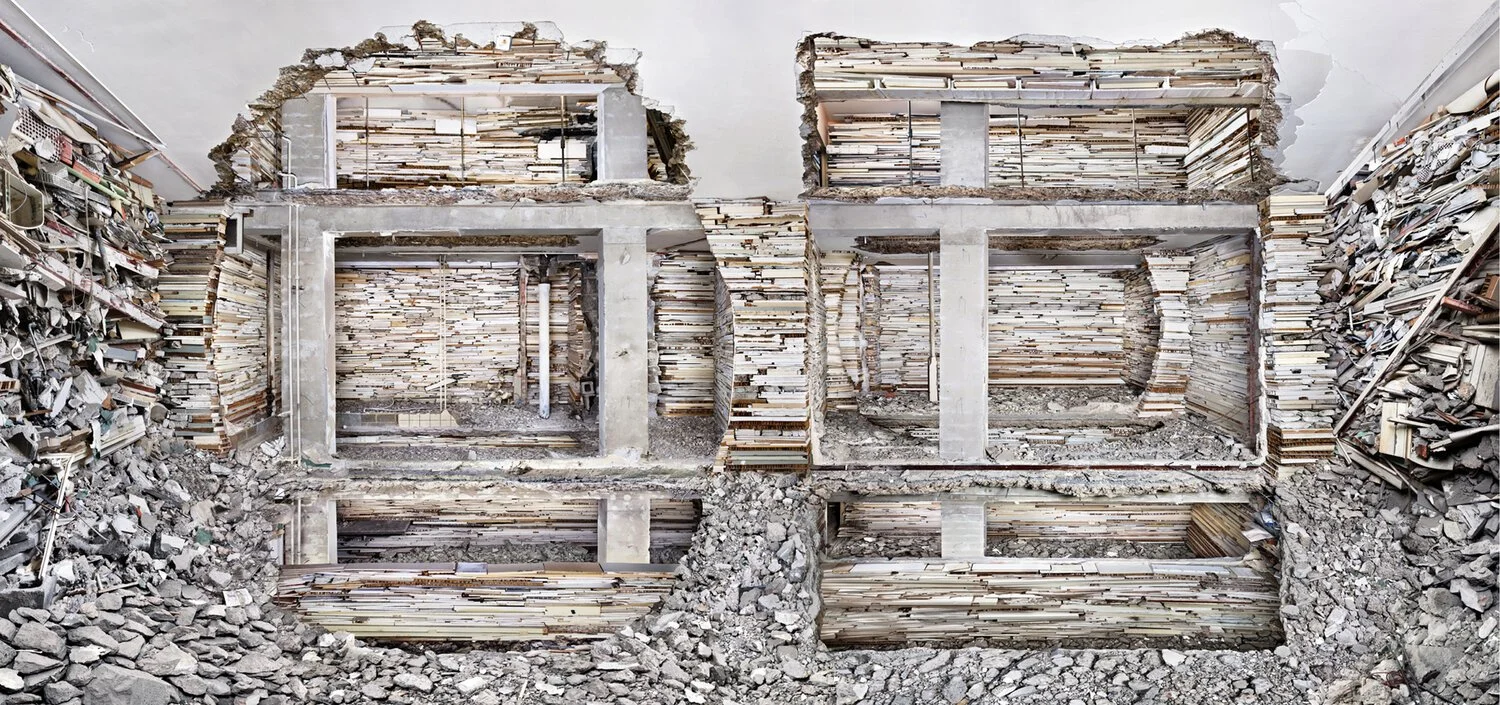MARJAN TEEUWEN: I am an Artist
Portrait by Andrea Blanch
Interview by Steve Miller
STEVE MILLER: So Marjan, your work is compellingly beautiful, and brings up a myriad of issues relating to culture in our shifting global political climate. This issue of Musée is about power, and the press release for your exhibition at Silverstein Gallery states that your images illuminate the precari- ous balance of the power of destruction with the constructive implications of order and function.
MARJAN TEEUWEN: My work deals with the polarity between the constructive and the destructive forces of mankind. People are very good at building up the world. We can build cities, we can go to the moon, but at the same time, we risk destroying our world. I often quote Dostoevesky, who believed that people couldn’t overcome that polarity. That’s the big important theme in my work, standing up & falling down, chaos, and order. Sometimes, I lean a little bit more to the side of destruction, falling down... but you can feel both always.
Marjan Teeuwen, Destroyed House Piet Mondriaanstraat 1, 2011.
STEVE: Yes, that’s interesting.
MARJAN: I never relate directly to critics... I’m not a politician, I’m not a journalist, I’m not a social worker, I’m an artist. So I use artistic language, not an activist language, not a political language. Imagi- nation is still the most important, but now it’s working in the context of a country.
STEVE: So you mentioned the power of destruction, and I saw that the spaces that you chose were valuable as a result of powerful destruction, of the war, or of the global forces of real estate develop- ment, and the displacement that that created.
Marjan Teeuwen, Destroyed House 1, 2007.
MARJAN: But you can see two sides. Social housing companies would demolish a flat, or a whole complex of two hundred apartments, and their goal was to realize new housing. And you can put that out positively or negatively. In Holland, it meant the end of an era of social housing thinking. Now, the real estate companies have more power, and they don’t care much anymore about the social conditions of people. They want to earn more money.
But it’s never directly political, it’s all in between. For example, the installation Rotterdam is known be- cause of its heavy bombardment during the Second World War. They were the most severely hidden city in Poland. That installation was just a long street of two level apartments. When visitors came, many of them were people who’d experienced a second world war, and it scared them. There are many minor- ity groups in the south further down where I worked, and they were reminded of earthquakes. People who’d experienced the war only saw chaos, falling down, and destruction. And other people only saw the beauty of new spaces. First, you see what’s in your mind, and then you see all the other sides. Rotterdam was the most ordered installation in my eyes. It was much, much more ordered than for example Leiden, or Mondriaanstraat, where the destruction was much much heavier. Rotterdam had aesthetics in it, but you could still always feel the destruction. For everybody it’s different.
STEVE: You embody in your work, more than any work I know, this dialectic between order and chaos; creation and destruction; dissection and reconstruction. In a way you are an aesthetic surgical strike force. So, how do you physically dissect a space?
MARJAN: The first building I found by myself, and all the others, social housing companies came to me and asked “Are you willing to realize an installation in our flat complex?” In Russia, it was a wooden construction, in an old wooden house, a hundred years old about. And, three times I worked in concrete buildings, which are very different, but I loved the challenge of coming into a new kind of building to see the possibilities. In Leiden, I had four buildings, and two houses. Two were from 1611, and the other two were 100 years old, so there were a lot of new possibilities; every building has special qualities.
Marjan Teeuwen, Above: Archive 6, 2012; Following spread: Destroyed House Krasnoyarsk 1, 2010.
STEVE: So your final project for every installation is a photo, the documentation. Do you have any idea what the photo will look like when you start going into a space, when you begin the process of demolition and reorganization?
MARJAN: The installation has two goals. There’s the architectural installation, as an object, as an environment, where people can come in. For example, in Leiden, 4,000 visitors were there during about three months. That installation is one specific goal I want to realize; it is very different from watching a film, and in equal importance for me, is realizing the photos. Mostly, I have one rough sketch, but it’s clear like you saw in Mondriaanstraat what it’s like, one circle and one triangle, and it’s very simple. “Then I need three floors, cut here, cut here.” I’m not worried about details or, how many meters, I think about depth and height, but it’s not detailed.
To read the full interview with Marjan Teeuwen click here.











